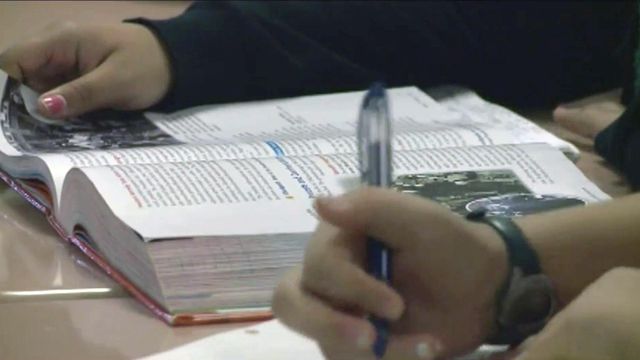State releases first school report cards
Amid concern from school leaders and teachers across North Carolina, the state Board of Education on Thursday approved new lawmaker-driven standards for grading public schools.
Posted — UpdatedKing, a teacher and librarian at Vance Elementary in Raleigh, says the C her school received under the state’s new school report cards does not reflect the academic progress students are making.
“I think the best word is misrepresentation,” she said about the report cards. “I think it's a very poor representation of what our children can do and what we can do.”
Results from 2,424 of the state’s 2,565 public and charter schools show that 41 percent received a C grade, 24 percent received a B and 5.4 percent received an A, according to the state Department of Public Instruction. Nearly a quarter (23 percent) received a D and 6 percent received an F.
When broken down by public versus charter, charter schools have the most A schools (11.2 percent vs. 5.1 percent) and B schools (29.6 percent vs. 23.7 percent) while traditional schools have the most lower-graded schools.
“These grades are not as bad as many people thought they would be, and they’re not as good as we want them to be,” state Superintendent June Atkinson said. “They’re a starting point, and I have faith in our teachers.”
The new lawmaker-driven standards for grading public schools, which were passed amid concern from school leaders and teachers across the state, are meant to give parents and administrators an at-a-glance reference to see whether a school is doing its job. Schools receiving a D or F must send a letter to parents informing them of their grade.
North Carolina now joins 12 other states that assign A-F grades to schools.
"It gives some schools some incentive, I believe, to improve themselves, to know how they really stack up against other schools," said Rep. Craig Horn, R-Union, chairman of the House K-12 education committee. "There’s a lot of discussion as to whether the formula should be adjusted. But at least A, B, C, D and F, people have a much more definitive idea of how that school is performing and will make judgments accordingly."
Nearly every school receiving a D or F have high percentages of low-income students, Atkinson said.
“It’s pretty obvious what the report does to poverty measures,” state school board member Buddy Collins said. “I think what’s important to recognize is that this is a measurement, not a contest. There’s a lot of schools doing a lot of good work that should not be defined by letter grades.”
Each school’s performance grade is made up of two elements – achievement score (80 percent) and academic growth (20 percent). Elementary and middle school achievement scores are based on state test results. For high schools, achievement scores are based on state test results, graduation rates and student performance on the ACT.
A school’s final grade will be based on a 15-point scale for the 2013-14 school year:
- A = 85-100
- B = 70-84
- C = 55-69
- D = 40-54
- F = 40 or less
A 10-point scale will be used for subsequent years.
When asked about the grading criteria, Atkinson said what determines a certain grade is relative.
“Instead of looking at the point spread, the big idea is looking at how one is in relation to another,” she said. “I believe it is important for the General Assembly, instead of going to the 10-point scale, to continue with the 15-point scale. One year does not a trend make. You need trends over time.”
Atkinson said she has visited classrooms where an F is a 75.
“Everyone knows what an A is and no one really knows what an A is,” she said. “And that’s the challenge of explaining the A-F system to the public.”
Ire from school leaders, teachers
The letter grade system was carved out of Senate President Pro Tem Phil Berger’s sweeping education reform package in 2012. The package was not passed in its entirety, but portions of it were rolled into the state budget and approved.
Proponents say the new accountability system exposes failing public schools in a way parents can easily understand.
Republican lawmakers approved the grading system in 2013 amid concern from Democrats that it would punish schools with a high percentage of low-income students. Those schools often have less resources than their more affluent peers, and opponents worry a low grade would deter potential teachers.
"We’re troubled by early knee-jerk reactions that appear to condemn poor children to automatic failure," Berger said in a statement Thursday. "And we reject the premise that high poverty schools are incapable of excelling, since today’s report shows numerous examples that are proving that myth wrong. We must give these grades a chance to work so we can learn from them and improve outcomes for our children.”
"We should measure what we value," Stein said. "The most important thing a school can do is to educate students. By increasing the weight on student growth, we will better know whether schools are teaching our students information over the course the year."
“We never believed placing a single grade on a school made much sense,” he said. “It simply falls short of the mark…what they do not offer is an explanation of why the information logically translates to a single grade for an entire school.”
“We feel this is a credible, transparent and logical way for parents to quickly appreciate the strengths and challenges of any school in our system,” Wake school board chairwoman Christine Kushner said in a statement.
Vance Elementary received high marks from teachers for its safe and supportive climate.
Those same teachers were displeased when their school’s grade was released.
“They groaned,” Principal Sarah Simmons said. “I told them you know we’re so much better than a C. Let’s talk about where we want to be and how we want to get there.”
"We think our schools should be graded more on what they actually accomplish during the school year and where their students were starting from," said Durham Public Schools Superintendent Bert L'Homme during a January school board meeting. He described the new formula as “not fair.”
Researchers recommended using a report card that has multiple indicators to reflect a school’s performance.
“Instead of focusing on A-F grades for our schools, we should be at the other end of the alphabet, S and T,” Ellis said. “Our attention should be on student success, small classes, textbooks, technology and teachers.”
Search Wake County school reports
• Credits
Copyright 2024 by Capitol Broadcasting Company. All rights reserved. This material may not be published, broadcast, rewritten or redistributed.






